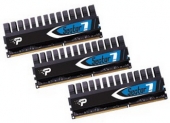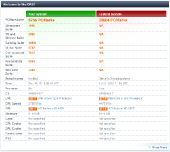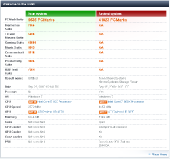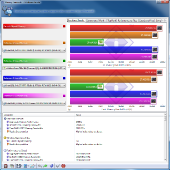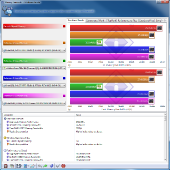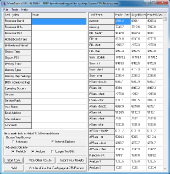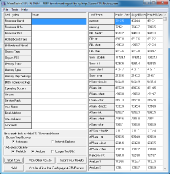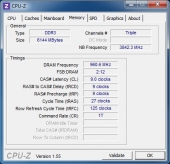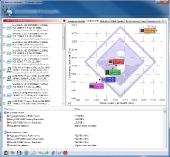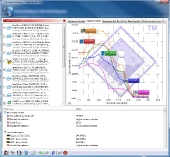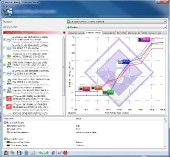Introduction
Cost versus performance analysis is a thought that manufacturers always keep in mind when it comes to RAM. If a manufacturer focuses too much on performance then the end result would be a product that has great performance, but is too expensive for the average user to obtain. On the other hand if a manufacturer focuses too much on the cost saving, the all you get is budget ram that no one really wants to put into their computer because it will hinder performance of other parts. Patriot seems very adamant about the concept of cost versus performance in the development of their RAM. With Sector 7, Patriot attempts to bring Extreme DDR3-Triple channel RAM to performance enthusiasts at relatively affordable price. Did they succeed? Read on and find.
Patriot’s Take
The Patriot Viper II Series, ‘Sector 7’ Edition, part of the Extreme Performance (EP) Enhanced Latency line, is the ultimate performance memory solution for the Intel® X58 chipset and Core™ i7 processors. The Viper II Series, ‘Sector 7’ Edition is built using only the highest quality pre-sorted IC’s available and are subjected to rigorous testing and validation on the X58 platform to achieve optimized performance and maximum quality. These modules are engineered to reach PC3-14400 (1800MHz) at 9-9-9-27 timings and are available in 6GB kit capacity (3 x 2GB). Each module is 100% hand-tested for quality assurance and is backed by a full lifetime warranty and industry leading customer service.
Specifications and Features
While some specifications listed below may seem irrelevant, there are important things to note. Firstly the particular kit we will be working with is the 2GB tri-channel kit. This means that there are 6GB total memory. The RAM was deemed Viper 2 Series noted for “Extreme Performance”. This translates to lower timings and faster speeds. Other important information about the is the operating voltage. Since the processor and the RAM are linked together, applying large voltages to RAM can prove fatal to the processor. The Sector 7 Series adheres to Intel’s 1.65 V maximum specification on the RAM. Furthermore the RAM contains an XMP profile which by default overclocks a processor to match the desired speeds.
Specifications
| Product Name | Extreme Performance |
| Patriot Part # | PV736g1800elk |
| Description | Viper II Series, Sector 7 Edition DDR3 6GB 1800 MHz Enhanced Latency Kit |
| Certifications / Safety | RoHS |
| Product Warrant | Lifetime Warranty |
| Unit Dimensions | 5.3” (L) x .27” (W) x 1.75” (H) |
| 13.4cm (L) x .69cm (W) x 4.4cm (H) |
Features
- Extreme Performance PC3-14400 (1800MHz)
- Enhanced Latency (9-9-9-27)
- Voltage: 1.65V
- XMP Ready
- Equipped with lightweight aluminum heat-dispersing shields
- 100% Tested and Verified
- Tested on Intel® X58 chipset 2/ Intel® Core™ i7 CPUs
–~~~~~~~~~~~~–
Testing and Overclocking
Testing Platform
- Chassis: LianLi PC-A77 Chassis
- Motherboard: ASUS P6T Deluxe
- Power Supply: Kingwin MACH 1 – 700W
- Processor: Intel Core i7 920 @ 2.66 GHz
- Ram: Corsair Dominator PC-12800 @ 1600 MHz
- Operating System: Windows 7 x64
Benchmarks
- CPUz
- PCMark Vantage
- SiSoft Sandra
- MemTach
CPUz
CPUz is not a benchmark, rather a tool used to provide information about system components. Below you have a couple of snapshots of the system components and the speeds at which they operate given specific settings of the testing process. In the first image below you can see the profile information of the Sector 7 RAM. By default the RAM will be given the JEDEC#2 profile which amounts to 1066MHz speeds. Once the machine boots up, the user will then have to go into the BIOS and enable the XMP-1800 profile to take full advantage of the RAM speeds.
The XMP profile automatically overclocked the processor form 2.66GHz to 2.7GHz. The image to the right of that represents the speeds of the processor after the RAM speeds have been increased by another 50MHz. The speed of the processor after overclocking was 2.77 GHz and at RAM speed of 1850 MHz. CPUz – Memory images below reflect the both the stock settings of the RAM as well as the overclocked settings of the RAM. The timings remained the same throughout the overclock.
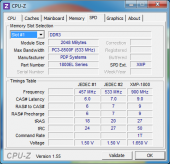 |
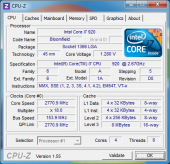 |
||
| CPUz – SPD | CPUz – CPU @ 1850 MHz | ||
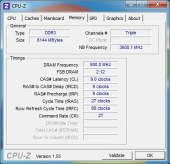 |
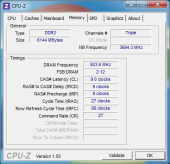 |
||
| CPUz – Memory @ 1800 MHz | CPUz – Memory @ 1850MHz (Overclocked) |
PCMark Vantage
The overall system score for the stock RAM speeds was 9766 PCMarks. The overclocked score was 9635 PCMarks. The difference in scores was most likely caused by instability form the overclock. Looking at individual scores, however, we can see that there is about 100 point improvement throughout almost every single category except for HDD Test Suite in the overclocked results.
| PCMark Vantage @ 1800MHz | PCMark Vantage @ 1850MHz |
SiSoft Sandra
Bandwidth
Similarly to PCMark, SiSoft Sandra is another synthetic benchmark that analyzes RAW performance of computer components based on inclusive tests. In this case, however, it serves well to measure results of the overclocking. As you can see in the images below, the RAM at stock speed was capable of attaining 28.688 GB/s memory bandwidth and was able to outperform a similar X58 system with the same speed but faster timings. A 50 MHz overclock of Sector 7 RAM improved the performance another GB/s yielding a result of 29.763 GB/s bandwidth.
| SiSoft Sandra Bandwidth @ 1800MHz | SiSoft Sandra Bandwidth @ 1850MHz |
Cache/Memory Bandwidth
This actual benchmark pertains to the bandwidth between the different caches in the processor. The processor uses the cache to store common instruction that are used in almost every operation for quick access. Not all instructions, however, can be stored inside the cache. When an instruction that a processor needs is not found, the processor has to fetch it from the memory. The faster the memory, the faster the processor can fetch the data. Faster numbers are imperative in this aspect. At 1800 MHz Sector 7 kit scored an impressive 72 GB/s and overclocking it another 50 MHz added another GB/s on top of that. In comparison to other model systems, the only ones capable of outdoing these ratings were kits rated at 2000 MHz and the margin by which they surpassed Sector 7 was not large at all.
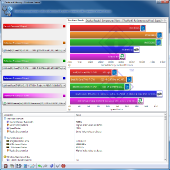 |
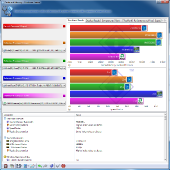 |
||
| SiSoft Sandra Cache @ 1800MHz | SiSoft Sandra Cache @ 1850MHz |
Latency
Latency refers to the time between when the request to pull information from the memory was made to when the RAM actually provided the information. The timings and speeds of the RAM modules play a key role in this test. This means that lowest scores are the best. After getting the latency, SiSoft Sandra does some black magic and outputs a “Speed Factor” based on internal calculations. For stock settings the our RAM’s latency was 60 ns and was only beat by RAM who’s speeds were clocked at 2000 MHz. At 1850MHz, the latency was 59 ns. The speed factors for both tests were 40.9 and 41.3 respectively.
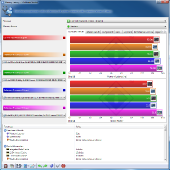 |
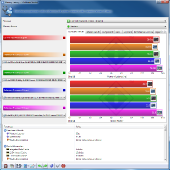 |
||
| SiSoft Sandra Latency @ 1800MHz | SiSoft Sandra Latency @ 1850MHz |
MemTach
Similarly to SiSoft Sandra tests, MemTach also runs a series of tests and analyzes them in order to determine speed of the RAM. In this case the tests are a series of mathematical and logical operations. MemTach measures the average, min and max speeds of the RAM. The total run time of the benchmark at stock settings was 12.5 seconds at stock speed. At 1850 MHz the benchmark too 12.15 seconds to run and displayed significantly better results in the min transfer rates of the benchmark. This is demonstrated in the memset test where the min transfer rate at 1850MHz is 7517MB/s compared to 4961 MB/s.
| MemTach @ 1800MHz | MemTach @ 1850MHz |
–~~~~~~~~~~~~–
Additional Overclocking
Despite the fact that we were able to overclock Sector 7 to 1850 MHz, we were not quite satisfied with the result. We therefore pulled out a different test system for the testing of the RAM. Using the new system we were successful to overclock it an additional 70 MHz to a total of 1920MHz. Special thanks goes to Chris for donating his system for testing. The main difference between the two systems that affects the RAM is the motherboard which is capable of higher speeds.
Testing Platform
- In Win Ironclad Case
- Intel Core i7-920
- MSI Big Bang XPOWER
- Patriot 256GB Torqx SSD
- Western Digital Caviar Green 2TB Drive
- Palit Radeon 4870 X2
- Ultra X4 1050 Watt Power Supply
- Windows 7 x64
CPUz
Below are screenshots detailing the new overclocked settings for the overclock setup. The processor was overclocked to 2.721 GHz as can be seen in the left image and the DRAM frequency was overclocked to 960MHz * 2 (1920MHz). Same timing as the original settings were used.
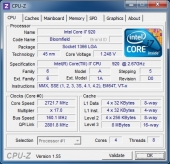 |
|||
| CPUz – CPU @ 1920 MHz | CPUz – Memory @1920 MHz |
PCMark Vantage
The overall score of the system was 11889 which was mainly due to the graphics card. However, focusing on the components, specifically the Memories Suite the performance of the RAM produced a lower score. This indicates that further overclocking might completely compromise the stability of the RAM.
SiSoft Sandra
Bandwidth
Further evidence of the instability of the RAM due to overclocking was evidenced in this program. When compared to the results obtained in the 1850 MHz, the 1920MHz produced a measly 13 GB/s as opposed to 29 GB/s.
Cache/Memory Bandwidth
Falling in trend with the rest of the benchmarks, the 1920 MHz overclock displayed regressive results. Where as the 1850MHz overclock proved to be an improvement over the stock 1800MHz at 73GB/s, the 1920MHz overclock scored only 50MHz.
Latency
The latency of the RAM also did not decrease. In fact, the latency scores obtained during the testing at 1850MHz proved to produce a better latency result of 59.6 ns as opposed to 59.8 ns at 1920MHz. The speed factor index at 1920MHz had a better score than that of 1850MHz, but still fell short when compared to the RAM at stock settings.
–~~~~~~~~~~~~–
Conclusion
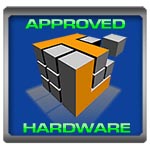
The original question regarding this product was whether or not they delivered an affordable product with good performance to enthusiasts consumers. Well at a price point of $190 for the kit it is rather pricey, but then take a look at the competition. Patriot’s Sector 7 1800 MHz costs the same amount as competitors 1600 MHz kits. So in the aspect of price the Sector 7 series passes with flying colors. Well what about the performance? Sector 7 delivered solid performance over what it claimed. There was no trouble and no resets after switching to the XMP profile. It also seemed that Sector 7 also delivered optimal performance over its specified speed. As demonstrated in the tests perusing higher overclocks impaired the RAM’s performance rather than enhancing it.
Given these facts we are happy to give the Sector 7 – PC3-14400 (1800 MHz) 6GB Kit our Approved Hardware Award.

